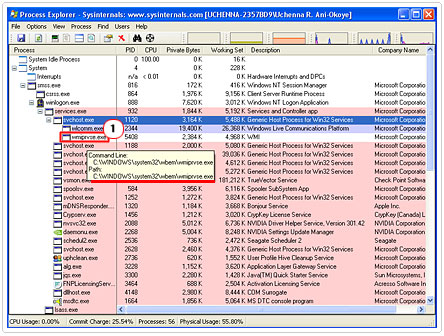-
High Cpu Usage Vista Svchost.Exe
How to fix: Svchost.exe (netsvcs) memory leak or high CPU usage problems. Svchost.exe is a generic and legitimate Windows process that loads several other critical. View Resources Usage by individual services in Windows 10. Exactly view the CPU and Memory usage of each service running under a svchost.exe process.
How to fix: Svchost.exe (netsvcs) memory leak or high CPU usage problems. Svchost.exe is a generic and legitimate Windows process that loads several other critical. View Resources Usage by individual services in Windows 10. Exactly view the CPU and Memory usage of each service running under a svchost.exe process.
View Resources Usage by Individual Services in Windows 1. Creators Update. With the Windows 1.


Cisvc.exe is a Windows operating system file and is part of the Windows indexing service – also known as the “Content Indexing Service”. However, there are.
Creators Update (codenamed “Redstone 2”) Preview Build 1. In Windows 1. 0 v. GB of RAM, each service would get its own service host (svchost. This lets you view the resources usage by each individual service. Resources here mean network, memory, disk and CPU usage. Starting from Windows 2. Windows 1. 0 v. 16.
In the shared service process model, to find which services are running under each svchost. Task Manager and click the chevron near “Service Host: ” to expand the selection. You can see the list of service hosted by that process. Or, use the Tasklist. Open a Command Prompt window and type: tasklist /svc. This shows the list of services running under each instance of svchost.
What is Audiodg.exe? Audiodg.exe is the audio component for both Windows Vista and Windows 7. Inside your Windows Task Manager, it is represented as an “Audio. A number of users have reported that trustedinstaller.exe reports high CPU usage from time to time and, more importantly, have asked us how to resolve this issue. Many users reported that RAM and CPU usage went up after installing Windows 10. The detailed situations of this Windows 10 high RAM/CPU memory usage issue are like.
I'm running Windows 7, and I've been experiencing high memory usage from one of my svchost.exe processes. Services under that particular process are BITS, EAPHost. Wat is SVCHOST.EXE? Waarom zijn er zoveel SVCHOST processen actief? Eenvoudig advies over svchost.exe en wat u kunt doen wanneer deze teveel CPU opeist.
Separate Service Host (svchost. Service. The above model has changed in Redstone 2, as the experts at Microsoft determined that the memory- saving advantage is not that substantial — given that systems are equipped with more than sufficient RAM these days. There are exceptions, though. System services which are deemed critical — the ones whose recovery require system restarts, and other select services will remain grouped. From what I’ve seen in the Creators Update Preview Builds, services that stay in groups are mentioned below: Set 1: Broker.
Infrastructure, Dcom. Launch, Power, System. Events. Broker. Set 2: BFE, Core. Messaging. Registrar, Mps. Svc. Set 3: One. Sync. Svc. If you’re a Windows 1. Insider running Build 1.
GB of RAM, you may have noticed those additional instances of svchost. There may be around 7. Whereas in Windows 1. Advantages of Running Services Ungrouped. As per Microsoft, ungrouping services provides these four advantages: 1.
Increase reliability: If a service fails, only that instance of svchost. Earlier, if one service failed, termination of svchost. Increase Transparency: You can now track the system resources (Memory, CPU, Disk and Network usage) used by each service, from Task Manager’s Processes tab, or in the Details tab with command- line column enabled. The Command- line column in the Processes or Details tab would show the short name of the service. For example: svchost. Windows Management Instrumentation” service.
Previously, to troubleshoot service failures and crashes or CPU usage spikes caused by svchost. Some of the methods include service isolation (using sc. See Svchost. exe troubleshooting. In Windows 1. 0 Redstone 2 systems with 3.
GB of RAM, since the services run under separate svchost. Problems include 1. CPU usage, or high memory usage and repeated crashes. Reduce servicing costs: Increased transparency of service processes would make troubleshooting easier. Technical support engineers can narrow down issues to the individual service and fix it quickly, which translates to reduced servicing costs.
Increase security: Process isolation and individual permission sets for services will enhance the security. Conclusion: So, after you install the Windows 1.
Creators Update (coming in 2. Task Manager. About the author. Ramesh Srinivasan founded Winhelponline. He is passionate about Microsoft technologies and has a vast experience in the ITe.
S industry — delivering support for Microsoft's consumer products. He has been a Microsoft MVP.
-
Commentaires
